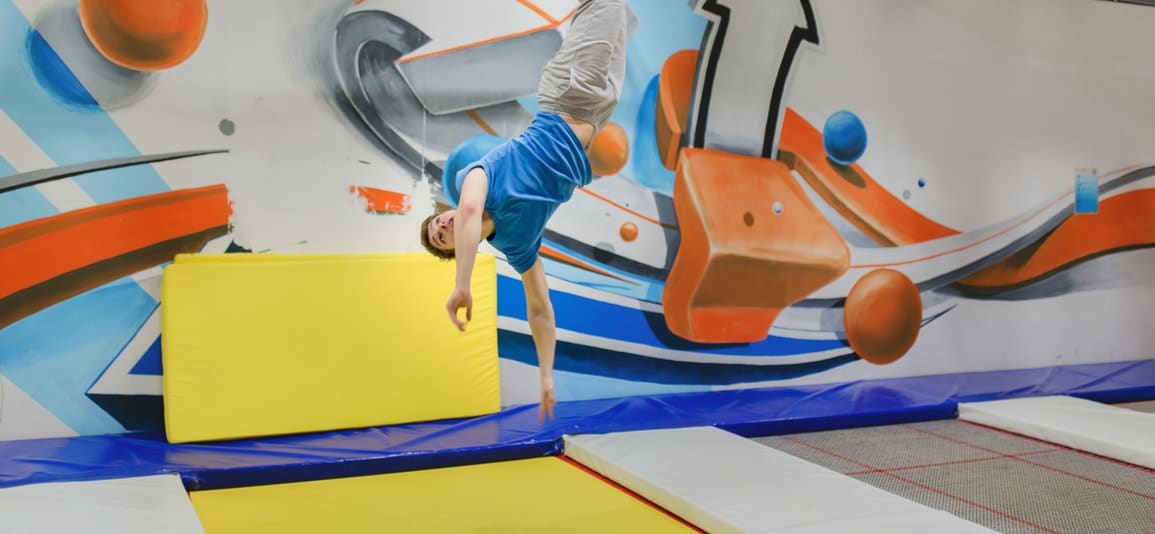Trampolines have been an American pastime for years. In the blistering Florida heat, however, jumping up and down in the bright sun may not be the ideal way to spend a summer day. Hence, indoor trampoline parks were born.
While the first indoor trampoline parks were not in Florida, over the past few years, trampoline parks have surged in numbers and popularity. According to the International Association of Trampoline Parks, there were only 35 to 40 trampoline parks in existence in 2011. In 2014, this number skyrocketed to 280. Today, with almost 600 facilities across North America, Broward and Miami Dade County are dotted with these indoor playgrounds.

Are Indoor Trampoline Parks Dangerous?
A 2016 study published by the American Academy of Pediatrics shows that as trampoline parks grow in popularity, injuries at the parks are increasing in tandem. In fact, trampoline park injuries have increased ten-fold in just four years.
Paying a visit to one of these indoor trampoline parks will reveal plenty of displayed safety signs, with a handful of employees supervising. Visitors are told that double bouncing, rough-housing, double flips, and climbing the padded walls are all strictly forbidden, and that participators should jump at their own risk and within their ability. Yet, despite these guidelines, a local news station recently revealed that teens are still regularly performing risky flips and jumping within a dangerously close proximity to one another.
According to the news station, in the past two years, close to 300 calls from trampoline parks across South Florida were made to 911 about injuries and falls. In at least 70 of these incidents, paramedics showed up.
The Personal Injury Debate
Recently, news broke of a South Florida teen whose ankle was broken after another visitor jumped on her ankle while she was landing at Off the Wall, a popular indoor trampoline park located in Coconut Creek. The teen, Alexandra Karob-Volpina, was rushed to urgent care. According to the 911 call log, 911 had been called more than 60 times in the last two years by the Off the Wall location where Alexandra got hurt. In fact, hers was one of two calls for help made that day.
Following the injury to her ankle, Alexandra required two surgeries as well as physical therapy, causing the teen to miss out on plenty of activities that kids her age typically enjoy. In response, Alexandra and her family filed a lawsuit against Off the Wall, the trampoline park were the accident occurred. And, she's not alone - the Broward Clerk of the Courts website revealed Alexandra's case is one of at least a dozen lawsuits filed against the company as a result of injuries.
The Emerging Lawsuit
Alexandra's lawsuit claims that Off the Wall was negligent, as they failed to have proper supervision, which ultimately resulted in Alexandra's injury. But, Off the Wall has told the court it cannot be held accountable for the teen's injuries - her father had signed a waiver before she mounted the trampoline.
Alexandra's father, Yan Karob, admits he signed the waiver, which contained strongly worded warnings including that Off the Wall's trampolines are “dangerous” and have “inherent risks.” Page three of the waiver contains a "Release and Promise Not To Sue" clause, in which Karob agreed not to take legal action if anything were to happen to his daughter, even in the case of death or negligence. Moreover, he agreed to pay for the cost of any claims filed against Off the Wall. This means that if he and his daughter lose their case, he will have to pay attorney fees for the trampoline park's attorneys.
While this might sound barbaric of the trampoline parks, when examining waivers of 13 other trampoline parks in South Florida, nearly all include the same wording. By signing it, parents and guardians are essentially agreeing to forfeit their child's right and their right to recover damages in a lawsuit that results from injuries or death.
But, do these waivers give companies a license to be negligent? To stay safe in these parks, the American Academy of Pediatrics policy statement on trampoline safety recommends a multitude of safety measures, including:
- Constant adult supervision
- Adequate protective padding
- 1 jumper per trampoline
- Avoidance of flips and somersaults
Alexandra and her father argue that since Off the Wall failed to have adequate adult supervision, they failed to uphold their end of the waiver. For this reason, they're arguing negligence.
Types of Injury Experienced at Trampoline Parks
Injuries at indoor trampoline parks are far from rare. Unfortunately, the enclosed trampolines, typically packed with kids, can result in a variety of injuries. Common types of injuries experienced at trampoline parks can be caused by:
- Falls on the trampoline mat
- Falls off a trampoline
- Impact with the trampoline frame or springs
- Collisions of multiple trampoline users
Most commonly these incidents can cause twisting of the lower extremities, such as the ankle or knee, broken or fractured bones, spinal fractures, head trauma including traumatic brain injury (TBI), and abrasions.
While seemingly a good time for all, indoor trampoline parks could be dangerous. Before you sign a waiver that forfeits your ability to recover damages in the case of an accident, be wary of where you're placing your trust. If you or a member of your family has recently experienced an injury while attending a trampoline park, contact the personal injury attorneys at Weinstein Legal today.


